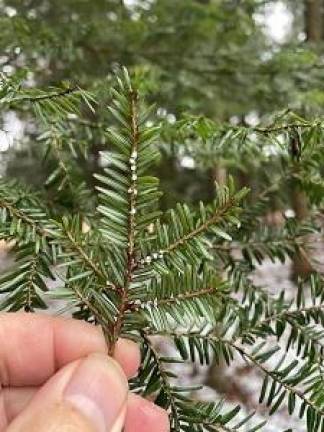Check for Hemlock Woolly Adelgid and Report to iMapInvasives
Did you know that winter is the best time to survey for invasive hemlock woolly adelgid (HWA)? This tiny insect is a big problem for forests and water resources in the Northeast.
HWA threatens an incredibly important native conifer, the eastern hemlock, which makes up large portions of the canopy in many New York forests and maintains water quality in streams by providing shade. HWA lives, reproduces, and feeds on hemlock trees, killing trees within four to 10 years.
While HWA is well-established in some parts of the state, it is an important early detection species in others. View the map on the NY iMapInvasives website to see where HWA has been recorded.
You can help by checking your trees for hemlock woolly adelgid and reporting your findings to iMapInvasives. Keep an eye out for small white “fuzz balls” on the undersides of hemlock twigs – these are HWA egg masses. Even if you don’t find any, let iMap know by submitting a “not-detected” report, as these reports are also essential in tracking the distribution of HWA.
Go to iMap’s website to learn how you can submit invasive species observations online or with the mobile app, and to sign up for upcoming trainings.
NYS Hemlock Initiative Conducts Biocontrol Release in Greene County: Controlling HWA with a beetle
Staff from the New York State Hemlock Initiative, in cooperation with DEC’s Invasive Species and Ecosystem Health program, recently released a predator beetle (Laricobius nigrinus) to control Hemlock Wooley Adelgid (HWA) on State land in Greene County. The NYS Hemlock Initiative has been researching this beetle and other biocontrol efforts for more than a decade to help stop HWA and the threat they pose to hemlocks (PDF). DEC and partners have been tackling HWA in parts of NY with a rapid response program relying on pesticides, but biocontrol is a better option for long-term management of HWA.
Laricobius beetles are specialist predators to hemlock woolly adelgid, meaning they only attack HWA. They feed exclusively on developing and adult HWA throughout the fall and winter seasons while HWA are in their first of two annual generations. Learn more about HWA biocontrol on the Initiative’s website
